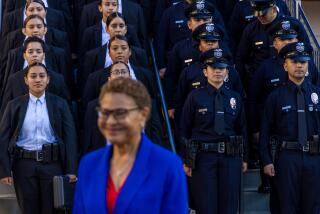LAPD’s data-driven culture under scrutiny amid scandal over fake gang identifications

- Share via
The Los Angeles Police Department has long been at the forefront of using data to help fight crime, even pioneering a program that uses statistics to predict where criminal activity is likely to occur.
But now, that data-driven culture is under scrutiny in the wake of a scandal in which 20 officers are under investigation following accusations of falsifying field interview cards to label individuals as gang members in an effort to boost statistics and populate a statewide gang database.
The Times obtained a Metro Division platoon recap sheet, which shows that officers were measured daily in 16 categories such as guns, citations and arrests. Field interviews of gang members were among the categories used to measure productivity.
A source familiar with the internal investigation said that Metro’s work emphasized guns and gangs and that its officers felt pressure to produce statistics in a results-driven department. The source spoke to The Times anonymously because the case is ongoing.
Los Angeles police officials said the recap sheets are one tool used to evaluate officers but stressed that such pressures were not an excuse to engage in misconduct.
“It doesn’t give someone the right to make it up,” LAPD spokesman Josh Rubenstein said. “It is one measure of productivity we look at. It is not the end-all, be-all. It is one of many.”
Data analysis has become a central tool used by police departments to better target resources and to monitor officer conduct. Some experts — and even some community groups — have praised the tactic for helping understand crime patterns and also providing red flags to potential bias and ineffective policing.
At the LAPD, station captains are grilled by higher-ups at weekly meetings about how to reduce crime, and crime statistics for each station are updated online every few weeks.
Asked whether the department’s heavy reliance on data might push officers to inflate statistics, Chief Michel Moore said that officers must work within the law and that the department is examining whether the scandal arose from some sort of department culture.
“We are looking into that,” he said. “I don’t know what would cause these men and women to game the system.”
Moore was expected to make initial discipline determinations last week for the first wave of cases under review in the investigation, but the chief said he requested more information after being briefed by internal investigators. He now expects to make the determination this week.
To combat a surge in violent crime, the Los Angeles Police Department doubled the size of its elite Metropolitan Division in 2015, creating special units to swarm crime hot spots.
The scandal came to light after a Van Nuys mother received a letter early last year from the LAPD saying her son was identified as a gang member during an interview with officers. She believed her son was misidentified and reported it to a supervisor at a nearby police station. Officials then reviewed body-worn camera footage and other information, and they found inaccuracies they attributed to the officer.
Metro officers are suspected of falsifying field interview cards during stops and entering incorrect information about those questioned in an effort to boost stop statistics.
The designation of being a gang member can carry harsh repercussions. Critics have long argued that police unfairly target blacks and Latinos as gang members with the use of field interviews in which officers ask those they pull over whether they have a gang affiliation.
While proving allegations of racial bias has been difficult, the incorporation of body cameras in the department has helped such efforts. Internal investigators have been reviewing videos to help determine whether officers falsified department reports.
The investigation into the Metro officers, however, is limited because the division was the last to be equipped with body cameras around June 2018, according to two law enforcement sources familiar with the probe.
One source said another issue is that hard-charging gang officers who worked in South Los Angeles were sometimes on unfamiliar turf when they joined Metro and were assigned to the San Fernando Valley.
They can’t produce the same results because they don’t know the gangs, the source said.
“You would get kudos all the way down from the top for getting gang members or firearms,” the source said. “No one wants to hear about [a field interview] card from a mom-and-pop [shop] down the street. They want gang intelligence.”
A top LAPD leader said those officers involved might try to explain away their misconduct, but any excuse is unacceptable.
“The fact we track those items is not an excuse for making stuff up,” said Assistant Chief Horace Frank.
The investigation initially focused on three officers and moved on to others who worked with them. It then expanded to additional officers who worked with the second group.
While data-driven policing has been credited with helping drive down crime in recent years, the LAPD also has been debating whether such tactics have limits.
Last year, the department scrapped a policing program it once hailed as a way to target violent offenders in neighborhood hot spots, following concerns that the programs unfairly target black and Latino communities.
Operation LASER started in 2011 as a way to pinpoint locations connected to gun and gang violence. But the department’s civilian oversight panel questioned the effectiveness of data-driven strategies that rely on algorithms and other computer technology to identify violent offenders and map the areas most prone to criminal activity.
The LAPD also tweaked a predictive-policing program last year, called PredPol, that critics claimed led to heavier policing of minority neighborhoods.
Moore also made an internal change to the review process for removing someone from the gang database. A bureau chief will now review the gang member’s appeal instead of an area captain, he said, adding: “The added layer is warranted” to “deepen” the review process.
The danger of data-driven policing is that the system is dependent on the accuracy and integrity of the data collectors, said Andrew Ferguson, a law professor at the University of the District of Columbia who studies policing data.
“Any intentional distortions in data collection undermine the legitimacy of the system,” he said.
Ferguson added that allegations such as false gang labeling further underscore the dangers of using subjective and largely unverifiable inputs to determine risk. He said using “gangs” as an input for predictive policing is “already prone to error and over-broad targeting and this just adds to a sense of distrust about the use of a flawed label.”
During a graduation ceremony Friday for new officers, Moore made no mention of the scandal. But he told the rookies that integrity and character are important traits on the streets.
“You cannot break the law to enforce the law,” Moore said. “How you go about your work shapes and molds us. Bring honor to your family and this department.”
More to Read
Sign up for Essential California
The most important California stories and recommendations in your inbox every morning.
You may occasionally receive promotional content from the Los Angeles Times.












